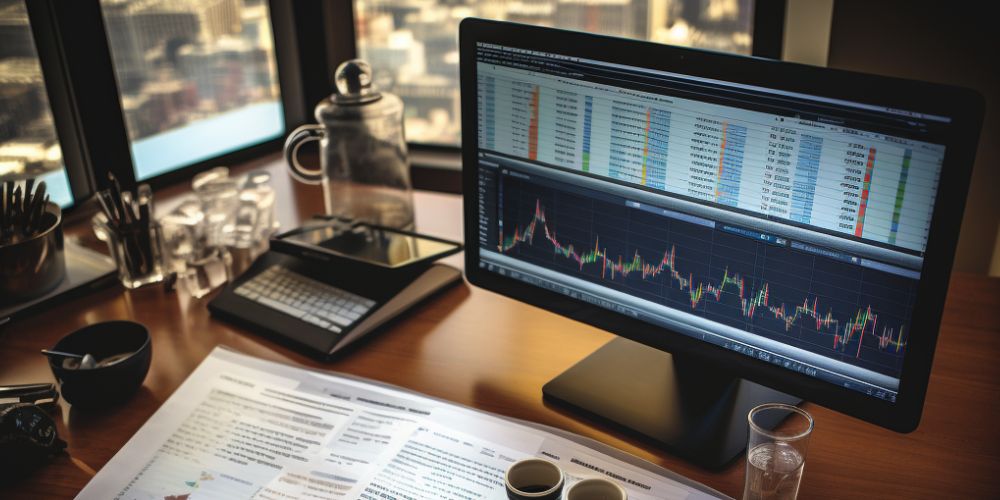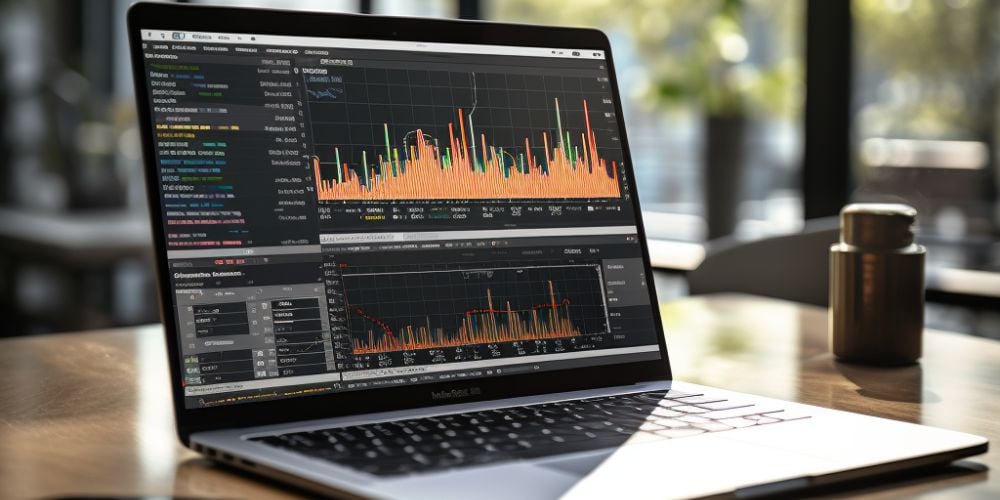Backtesting is the cornerstone of sound trading strategies. It helps traders evaluate the effectiveness of their trading systems by measuring their performance against historical data.
Backtesting allows traders to fine-tune their systems and make data-driven decisions.
In this article, we will go through the detailed steps of how to backtest a trading strategy effectively.
We will also provide some pro tips and best practices to help you optimize your trading strategies.
Understanding the Basics of Backtesting in Trading
The first step in backtesting a trading strategy is to gain an understanding of what it is and how it works.
Backtesting involves the use of historical data to assess the effectiveness of a trading strategy. Historical data provides a snapshot of how the market performed in the past, and traders can use that data to test their systems.
When backtesting, it is essential to have a strong understanding of the key components of a trading strategy.
These include the trading system/platform, trading goals, market conditions, and entry and exit rules. The trading system/platform is the software used to execute trades.
It is important to select a platform that provides reliable and accurate data. Traders must also define their trading goals and objectives, including profit targets and risk tolerance.
Lastly, traders must determine the market conditions they want to trade in, including the timeframes they will use. It is important to select relevant indicators and parameters that align with the chosen market conditions.
Determining entry and exit rules is also a crucial step in defining a trading strategy. Traders can use technical indicators and chart patterns to make these decisions.

How to Backtest A Trading Strategy? (A Step by Step Guide)
Gathering Historical Data
After defining a trading strategy, the next step is to gather historical data.
Historical data can be obtained from a variety of sources, including market data providers like Yahoo! Finance, Bloomberg, and Google Finance. Traders should select historical data that aligns with their trading goals and objectives.
One of the most significant challenges in backtesting is ensuring historical data is accurate and consistent.
Traders must regularly review data for errors and inconsistencies. Before using historical data, traders should clean and organize it, removing any outliers or duplicated records.
Performing the Backtest
Once traders have defined their trading strategies and gathered historical data, they can perform a backtest.
The backtest allows traders to test their strategies against the historical data and assess their effectiveness.
When performing a backtest, it is important to set up the backtesting environment correctly. Traders should input relevant trading parameters and run the backtest.
After running the test, traders can analyze the results and interpret performance metrics and statistics, including profitability, risk/reward ratios, and drawdowns. Interpreting backtest results accurately is a vital step in refining trading strategies.
Refining and Optimizing Strategies
Refining and optimizing trading strategies is an ongoing process that requires attention to detail and continuous improvement.
Here are some additional points, subtopics, and tips to make the most out of this crucial step:
Analyzing and understanding backtest results:
Dive deeper into the performance metrics and statistics provided by the backtesting software. Look for insights into profitability, risk/reward ratios, and drawdowns.
Pay close attention to key performance indicators such as the Sharpe ratio, maximum drawdown, and average profit per trade. These metrics can provide valuable insights into the risk-adjusted returns and overall performance of your strategy.
Compare the backtest results with your trading goals and objectives. Evaluate whether the strategy meets your predefined criteria for success.
Identifying areas of improvement:
Examine the specific trades that resulted in losses or underperformance. Identify common patterns or trends that may indicate a need for adjustment.
Assess the impact of different market conditions on your strategy’s performance. Consider whether your strategy is robust enough to handle various market environments, including trending, ranging, or volatile markets.
Review the selection of indicators and parameters used in your strategy. Determine if there are more effective or relevant indicators to consider.
Assess the impact of transaction costs, slippage, and other trading fees on your strategy’s profitability. Consider whether adjustments need to be made to account for these factors.
Tweaking trading strategy parameters:
Make incremental changes to your trading strategy based on the insights gained from the backtest results. Avoid making drastic modifications that can introduce unnecessary risks.
Consider adjusting the entry and exit rules, stop-loss and take-profit levels, or trailing stop parameters. Experiment with different combinations to find the optimal settings.
Test different timeframes or market conditions to see how your strategy performs across a range of scenarios.
Keep track of the changes you make so that you can compare the performance of different iterations of your strategy.

Iterative testing and optimization techniques:
Conduct multiple rounds of backtesting to refine and optimize your strategy further. Each iteration should focus on addressing specific areas of improvement identified in the previous round.
Use walk-forward testing, which involves splitting historical data into multiple segments and testing on each segment separately. This technique helps assess the robustness of your strategy by simulating real-time trading.
Consider applying robustness tests, such as stress testing or Monte Carlo simulations, to evaluate the performance of your strategy under different scenarios and potential market shocks.
Keep a record of the changes made at each iteration and document the corresponding performance metrics. This will enable you to track the progress and compare the results of different versions of your strategy.
Implementing robust risk management practices:
Pay attention to risk management parameters, including position sizing, stop-loss orders, and risk per trade. These parameters are crucial for managing downside risk and preserving capital.
Consider using trailing stops or dynamic position sizing techniques to adapt to changing market conditions and protect profits.
Regularly review and update your risk management practices as market conditions evolve and as you gain more insights from backtesting and live trading.
Common Pitfalls and Challenges in Backtesting
Backtesting is not without its pitfalls and challenges. Being aware of these risks will help you navigate through the process more effectively.
Here are some additional points, subtopics, and tips to consider:
Overfitting and curve-fitting risks:
Overfitting occurs when a strategy is overly optimized to perform well with historical data but fails to adapt to new or unseen market conditions.
Avoid fitting your strategy too closely to historical data as it may result in poor performance going forward.
Be cautious when selecting indicators and parameters. It’s important to strike a balance between over-optimizing and under-optimizing your strategy.
Consider using out-of-sample testing to validate your strategy’s performance on data that was not used during the initial testing and optimization phase. This can help identify if your strategy has been overfit to historical data.
Practical considerations and limitations:
Take into account the limitations of backtesting software or tools you are using, such as potential inaccuracies or incomplete data. Regularly update your data sources to ensure the most accurate historical data.
Be mindful of any unrealistic assumptions made during the backtesting process, such as perfect execution, no slippage, or unlimited liquidity. Consider incorporating these factors into your backtesting to reflect real-world trading conditions.
Understand the limitations of backtesting in capturing all market dynamics, including sudden news events or market manipulation. Backtesting is a valuable tool, but it cannot predict or reflect every possible scenario.
Interpreting backtest results accurately:
Take a holistic view of the performance metrics and statistics derived from backtesting. Avoid focusing solely on individual metrics, as they may not provide a complete picture of your strategy’s performance.
Consider using benchmarking to compare your strategy against relevant market indices or other established benchmarks. This can help you assess whether your strategy outperforms or underperforms the broader market.
Understand that backtesting provides historical performance and does not guarantee future results. It is crucial to regularly monitor and adapt your strategy as market conditions change.
Dealing with unexpected market conditions:
Prepare yourself for unexpected market scenarios that may deviate from historical patterns. Backtesting primarily relies on historical data, and it may not account for extreme or black swan events.
Consider stress testing your strategy by simulating adverse market conditions or scenarios that are outside the norm. This can help you assess how your strategy performs in worst-case scenarios.

Backtesting with Automation and Technology
Automation and technology have revolutionized the backtesting process, allowing traders to save time and optimize their strategies more efficiently.
Here are some additional points, subtopics, and tips to consider when leveraging automation and technology in your backtesting:
Introduction to backtesting software and tools:
Explore popular backtesting platforms such as MetaTrader, TradingView, Amibroker, or QuantConnect. These platforms provide intuitive interfaces, robust backtesting engines, and access to a wide range of historical data.
Consider using specialized software that focuses on specific asset classes or trading styles. This can help to streamline your backtesting process and provide more tailored analytics.
Advantages and limitations of automated backtesting:
Automated backtesting allows for faster testing and optimization of multiple strategies simultaneously.
Automation helps eliminate emotional biases and ensures consistent execution of your strategy.
Be aware that automated backtesting may not capture all nuances of manual execution, such as partial fills or slippage.
Take this into account when reviewing your results.
Exploring programming languages and frameworks for backtesting:
Consider learning programming languages such as Python or R, which offer powerful libraries and frameworks specifically designed for backtesting and quantitative analysis. These languages provide flexibility and customization options.
Familiarize yourself with popular backtesting frameworks and libraries like backtrader, Zipline, or Quantopian.
These tools provide built-in functionality for data handling, strategy development, and performance analysis.
Considerations for algorithmic trading strategies:
Algorithmic trading strategies often require backtesting on smaller timeframes, such as tick data. Ensure that your backtesting software or tools can handle high-frequency data efficiently.
Market microstructure factors, like bid-ask spreads and order book dynamics, are crucial for algorithmic trading strategies. Verify that your backtesting platform accurately models these microstructure elements.
Remember to keep adapting your strategies and stay updated with the latest advancements in automation and technology.
While technology can streamline the backtesting process, it’s important to combine it with critical thinking and a deep understanding of market dynamics.
Best Practices and Pro Tips
Continuous learning and adaptation are essential for backtesting. Traders must keep up to date with trends, algorithms and techniques to optimize their backtesting process.
Keeping a trading journal and analyzing trading strategies is also recommended.
While backtesting, traders should test multiple strategies and compare results. It is suggested that realistic slippage and transaction costs be factored into the testing process.
If traders encounter challenges, they should consider seeking expert guidance and mentorship.

FAQs
Why is backtesting important?
Backtesting helps traders assess the potential effectiveness of their strategies before risking real capital. It allows for strategy optimization and provides insights into historical performance.
What is overfitting in backtesting?
Overfitting refers to excessively optimizing a trading strategy to perform well with historical data but potentially fail in real-world conditions. It is a risk to be aware of when backtesting.
Can backtesting guarantee future success?
No, backtesting provides historical performance and does not guarantee future results. Markets are dynamic, and the effectiveness of a strategy can change over time.
Should I backtest my strategy on different timeframes?
Yes, testing your strategy on different timeframes can help you assess its performance under various market conditions and validate its robustness.
How often should I backtest my strategy?
You should backtest your strategy whenever you make significant changes to it or at regular intervals to ensure its ongoing effectiveness.
Additionally, perform forward testing to validate your strategy in real-time market conditions.
Conclusion
Backtesting can help traders optimize their trading strategies and improve their profitability.
By understanding the basics of backtesting, traders can refine their strategies and make data-driven trading decisions.
Through iterative testing and optimization techniques, traders can identify the optimal strategy best suited to meet their trading goals and objectives.
Remember to keep your trading journal up-to-date and incorporate expert guidance and mentorship where necessary.


 Tags:
Tags:










